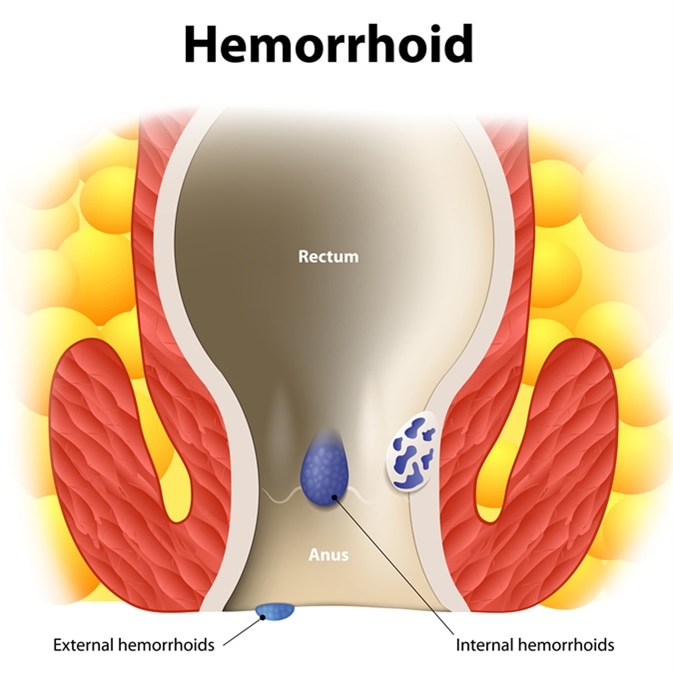Also known as a pile, a hemorrhoid is a swelling in the anal canal or around the anus with an enlarged blood vessel inside it. When tissue in these areas becomes swollen, possibly due to constipation and straining too much during a bowel movement, a hemorrhoid can develop. If the hemorrhoid becomes damaged, this can lead to pain and bleeding. Heavy lifting and other strenuous activities can also result in hemorrhoids.

Hemorrhoids are often not associated with any symptoms and people may be unaware they have them. However, if symptoms do develop, they may include the following:
- Bleeding and/or pain on passing a stool
- A lump around or inside the anus
- Sense that bowel emptying has been incomplete
- Itchiness or soreness around the anus
- Mucus discharge from the anus
Prevalence
Worldwide, the overall prevalence of hemorrhoids in the general population is estimated to be 4.4%.
There has been a paucity of literature reporting on the epidemiology of hemorrhoids and prevalence is not well documented. However, experts have noticed that in the United States (US) and United Kingdom (UK), the number of people visiting hospital as a result of hemorrhoids has fallen.
The “HD Treatment Center,” a provider of hemorrhoid treatment in North Carolina has published some statistics to create some awareness about the incidence of hemorrhoids.
According to the HD Treatment Center, estimates suggest that around half of Americans develop hemorrhoids by time they are aged 50 and only a small proportion of those people seek therapy. The number of people in the US suffering from hemorrhoids is estimated to be around 10.4 million and 1 million new cases occur each year. Ten to 20% of those new cases require surgery.
Gender
The HD Treatment Center has also found that among people older than 45 years, 25% of people who develop hemorrhoids are female and 15% are men. Research has also shown there is a greater likelihood of men seeking treatment for their hemorrhoids than there is for women.
Physiological changes that occur during pregnancy also increase the likelihood that hemorrhoids will become symptomatic and may increase the incidence of diagnosed cases in females.
Race
There is a paucity of data on the incidence of hemorrhoids by race, although it has been shown that there is a greater likelihood of Caucasian individuals seeking treatment compared with other races.
Genetics
Some individuals are more genetically predisposed to hemorrhoids than others.These people should take measures to decrease the likelihood of them developing the problem.
Age
Age is known to influence hemorrhoid risk, with the likelihood of hemorrhoids increasing as a person ages. In most cases, hemorrhoids develop in individuals who are over 30 years old, although they can develop at any age.
Location and Socioeconomic Status
People who live in rural areas and those with a higher socioeconomic background apprear to be more likely to be affected by haemorrhoids.
Treatment
The number of patients that require surgical removal of hemorrhoids, known as a hemorrhoidectomy, in hospitals in the United States is declining. It reached a peak in 1974 with 117 hemorrhoidectomies per 100,000 people, which dropped to 37 in 1987.
Sources
- http://link.springer.com/article/10.1007/s00384-011-1316-3
- http://hdtreatmentcenterofraleigh.com/hemorrhoids-by-the-numbers/
- http://www.bupa.co.uk/health-information/directory/h/haemorrhoids
- www.jstage.jst.go.jp/article/jcoloproctology/63/10/63_10_819/_article
Further Reading
- All Piles (Haemorrhoids) Content
- Piles – What are piles?
- Causes of piles (haemorrhoids)
- Symptoms of piles (Haemorrhoids)
- Diagnosis and treatment of piles (Haemorrhoids)
Last Updated: Feb 26, 2019

Written by
Sally Robertson
Sally has a Bachelor's Degree in Biomedical Sciences (B.Sc.). She is a specialist in reviewing and summarising the latest findings across all areas of medicine covered in major, high-impact, world-leading international medical journals, international press conferences and bulletins from governmental agencies and regulatory bodies. At News-Medical, Sally generates daily news features, life science articles and interview coverage.
Source: Read Full Article
